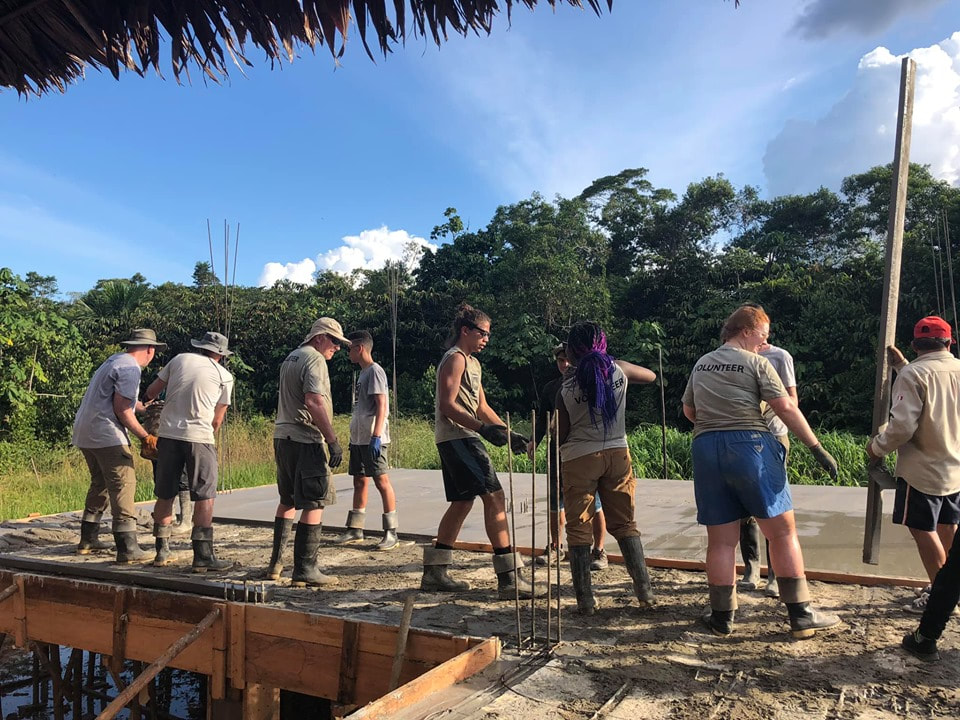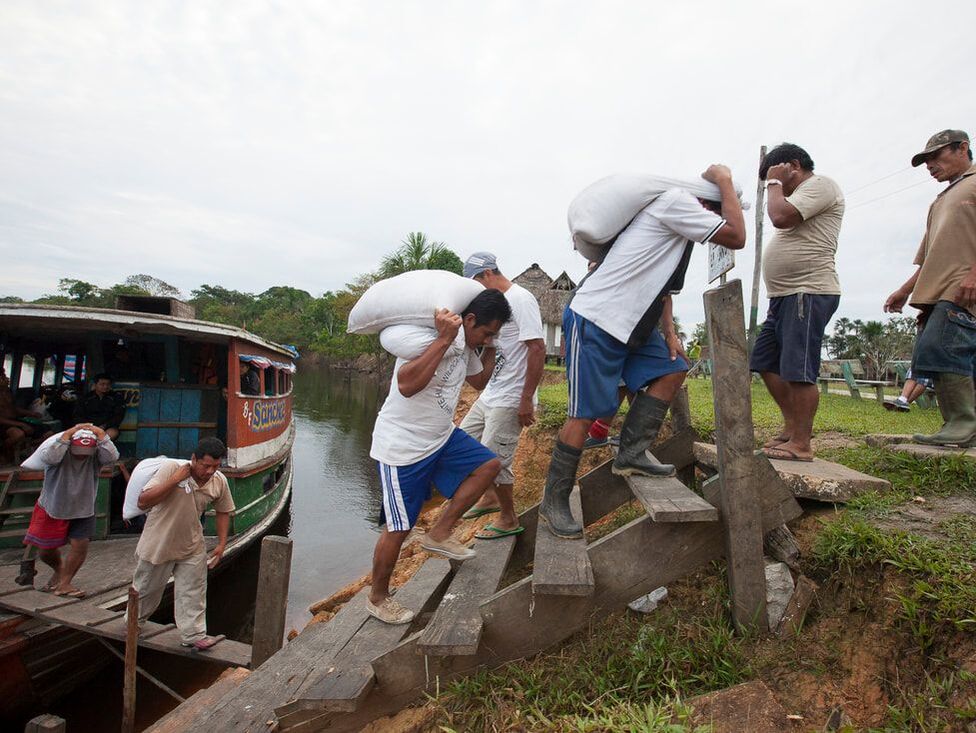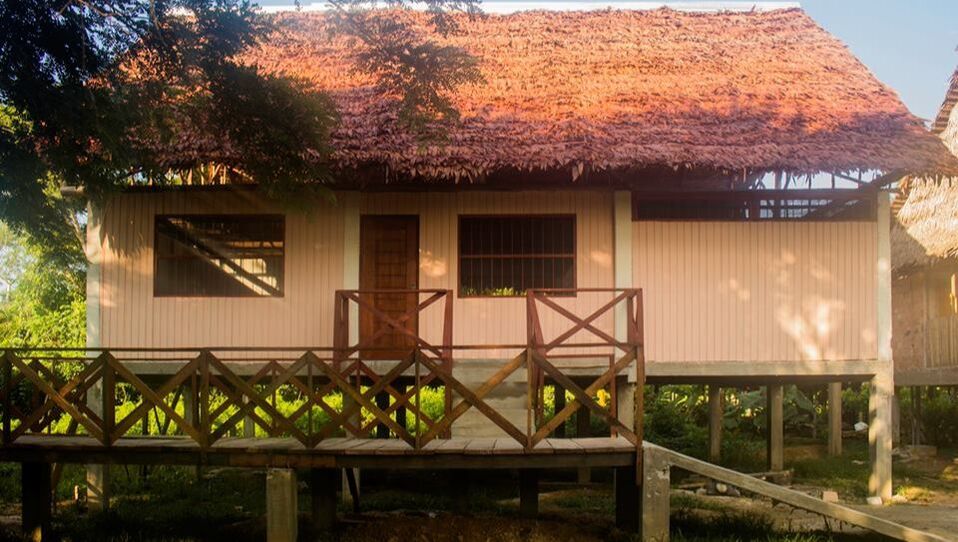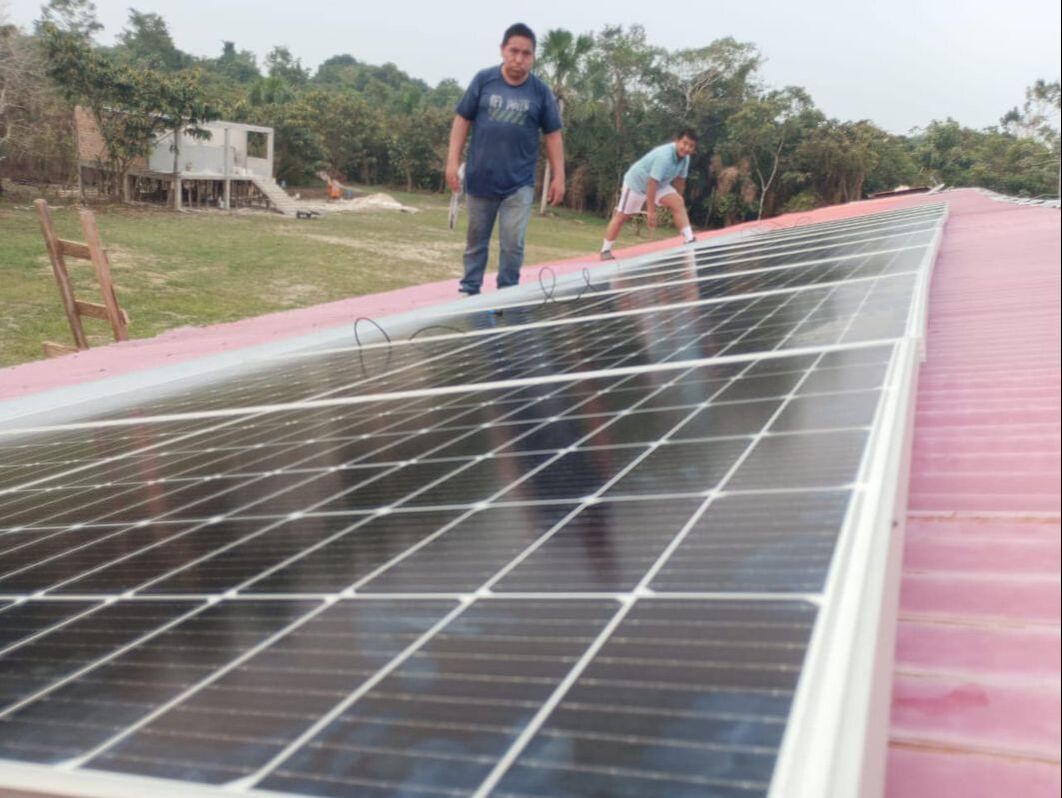The Jane Gordon Cook
Primary and Secondary School
EL Chino, Peru
Welcome to the Jungle... a flight, a drive, and one amazing boat ride takes Changers into the Peruvian Jungle by way of the mighty Amazon River to the village of Chino, Peru. Here the local community is waiting for you to join them as we work together to build their beautiful new high school campus.
Community activist, Dolly Beaver, and her organization Angels of the Amazon (AoA) have worked in the region for over 30 years serving the underserved by promoting health, education, and the empowerment of women. As part of their education initiatives, AoA wanted to see the students of Chino Village have local access to quality education opportunities after elementary school. In this village, the government had only provided an elementary school. Dolly mobilized the community and together they opened a makeshift high school in a communal building. The Chino community's dedication to providing a high school education for their children gained the attention of the Ministry of Education, and eventually certified government teachers were sent on rotation to Chino High School. To be successful long term, AoA knew they would need dedicated infrastructure and additional resources in the form of a complete high school campus. In 2014, AoA sent an application to BTCV asking for education-focused development aid to help them accomplish this dream.
The BTCV Board of Directors sent site evaluators to Chino village to conduct an onsite needs analysis based on interviews with community leaders, teachers, parents, and students. It was obvious from these first interactions that the Chino Community was fully committed to partnering with BTCV for a sustainable solution for education for their kids.
Site evaluators took into consideration the catastrophic flooding that had hit the region in years past and would inevitably happen again one day. This issue of flooding was among the primary problems related to access to education year-round. At the time, the only dedicated educational facility in the village was a government elementary school that was not built to account for even the normal flooding that occurs with the large seasonal changes in the river stage. Unfortunately, this rendered the elementary school unusable for months at a time each year during the high water season - and then after the flooding subsided because of needed cleanup and repairs. As a result, students in the village were often not able to keep up with the expected educational requirements and milestones. Fortunately, the Chino community had the foresight and commitment to donate land for the high school project that was a quarter mile back from the river's edge and on high ground.
BTCV evaluators visited multiple buildings to learn about the local construction styles and materials that would make the most sense for this project. Modern concrete piers would involve more initial costs but would provide a much longer-lasting foundation for the classrooms. To stay within budget and still get quality infrastructure in place for the Chino students, we put together a long-term phased building plan that included BTCV funding for concrete pier foundations and wood-plank walls with Chino Families each contributing to the work as well as providing a full section of thatch roofing for each of the five planned classrooms - this full community buy-in was profound and inspiring. Once all classrooms were completed, BTCV would provide funds and send teams to replace the thatch roofs with beam trusses and metal roofing material. This phase-building strategy allowed for immediate solutions and long-term sustainability through a realistic fundraising strategy and partnership plan that were feasible and on a mission.
The BTCV Board of Directors approved the project and initial construction funds were sent to AoA's team to begin construction of the concrete piers for classroom #1 using local skilled laborers under the supervision of an engineer from the University of Iquitos. Once the foundation was ready, BTCV sent the first team of volunteers to Peru to work with the community on the walls and roof to complete classroom #1 and get the Chino students in high school.
Typically, BTCV teams meet up in the Dallas airport and head south to Lima on a red-eye. From Lima, the team then flies to Iquitos. A fun fact is that Iquitos is the largest city in the world that cannot be reached by road - the only way there is by plane or boat. On arrival at the Iquitos airport, the team meets up with guides from Amazonia Expeditions, a distinguished eco-tourism company that was started by Dolly's husband, Dr. Paul Beaver, over 30 years ago. The guides load the team up on a bus and drive through Iquitos to the banks of the Amazon River where the team boards a passenger power boat and heads out on an amazing Amazon River journey to Amazonia Expedition's Tahuayo Lodge.
Each morning, the team boards small boats for a 10-minute ride down river to Chino Village. Here, they work each day with the community on the construction of buildings and furnishings for the high school campus, as well as many other education focused resourcing projects and relationship-building cultural exchange activities.
After the first year, BTCV and the Chino Community decided that it would be great to work together on both parts of each classroom - the foundation and then walls and roof, but to allow time for the concrete to cure, we would have to split the volunteers up into to teams separate by at least a month. So, we decided to develop a relay team approach in El Chino - the first team of Changers builds the foundation with the community during the summer and the second team comes in the fall to build the walls and roof with the community. We call them Relay Team 1 and Relay Team 2 ...and, yes!, we have a real relay race baton that they hand off every year!
Each year Relay Team 1 sets the foundation for the infrastructure working with local volunteers and skilled tradesmen to assemble the ring beams and columns. Then, they do some very heavy and very messy lifting by hand mixing and hand pouring all of the concrete one bucket at a time.
After the concrete has been given extensive time to cure in the humid jungle environment, Relay Team 2 arrives to install the walls and roof with the community. Team members cut every plank of timber and nail it into place while assisting locals who are skilled in producing the amazing bush roof structure.
In 2014, the community and team completed classroom #1, new student desks and chairs, and a teacher's desk. One of the most special stories from that first year was the heartfelt and impassioned comment from one of the teachers as she took her seat behind her new teacher's desk in her new classroom, "Oh, this is so beautiful, I have never had a desk before!"
Building furnishings for classrooms is a special project. We hire local carpenters to prepare all of the components to assemble school desks and chairs. Then, in an effort to connect the community and teams in all aspects of the work, we ask them to work together on assembling and finishing all of the furniture. Changers always highlight this as one of the most enjoyable parts of a project in Chino - kind of like putting together a giant puzzle while learning your partner's language as you go.
As plans were being made for classroom #2, our ongoing needs analysis revealed that teachers and students were walking a quarter mile back to the village to use the bathroom. This was a major interruption to the school day, so with fundraising help and generous support from the Van Vechten Family, BTCV was able to install an on-campus bathroom block along with classroom #2. This bathroom block included separate boys and girls facilities and the first biodigestor in the village to maximize privacy, hygiene and sanitation.
El Chino is a special place where we have again seen true commitment and engagement from our community partners. All of the modern materials such as cement and steel must be transported down the Amazon River by rustic river barges. The community then offloads and secures all of the materials onsite as part of their volunteer-work even before the BTCV team arrives. This is HEAVY work!!! In 2018, we saw how every single piece of material matters more to this community than we could have ever imagined... The barge transporting supplies hit a sandbank that was hidden beneath the river waters. Community members rushed to the crash site on boats and literally dove for hours to salvage as much of the supplies as possible. The cement for the 2018 project was lost in the crash, but thanks to the extreme generosity of BTCV supporters from around the world who immediately stepped up with additional donations, we were able to replace it in time for the project to resume and be completed on time.
The third and fourth classrooms were also completed on time the following two years. While the original plan called for the first 5 classrooms to be completed consecutively, thanks to our ongoing needs analysis process through close communication with our community partners, we were able to determine other needs that should be prioritized. And, thanks to the generous ongoing support for the El Chino Campus provided by the Downey Family, we were able to adjust and address these priorities right away.
BTCV completes an initial needs analysis before starting each new project. Our needs analysis process continues throughout the entire project so that we can adjust and re-prioritize as needed. We conduct annual interviews with teachers, parents, students, leaders and stakeholders at the partner school. We also require annual reporting and a completed Returning Partner Application for each phase of the project. This helps us understand many aspects of the construction project related to market changes for materials, logistics, technology advancements, community growth, and other factors that can influence the phased building plan.
Our ongoing needs analysis for Chino revealed that Teacher Housing had become a big issue. After completing three new classrooms, available housing for teachers who were not from El Chino was insufficient. The only accommodations available to the teachers who were assigned to this school by the government was in disrepair, and for this teachers who did not grow up in the jungle, it was also not what they were used to, so the community wanted to address their needs to make sure the teachers were comfortable in the community. BTCV firmly believes in providing teachers with the tools they need to be successful and to ensure that they know they are valued. So, BTCV and the community agreed to shift the plans and provide a nice multi-family teacher housing unit in Chino.
Ongoing needs analysis also revealed an issue related to safe and effective access to the high school campus. For half of the months of the year, there were no issues as students could easily walk down the trail from the village to the school in the dry season and paddle their canoes right up to the classrooms in the high-water season. But in the transitional months - about half the year - they could not easily or safely (eg falling and snakes!) walk or canoe to school. BTCV had a BIG idea! What if we were able to create a walkway bridge the same height as the classrooms all the way from the new teacher housing in the village to the new classrooms about a quarter mile back on high ground in the jungle?!
A generous donor heard the idea and with their full support, the project moved forward. When it was completed, the elevated walkway was dubbed, The Willett Family Bridge to the Future, because it created safe and effective access to education - and education creates a better future for all of us. This is just one more unique example of how BTCV is using needs analysis to create unique solutions to the underlying challenges related to access to educational opportunities for deserving students around the world.
Classroom #5 was completed in 2019 and thanks to the generous support of donors, it is the first classroom to be completed with a modern metal roof. This completed the first part of the master plan for 5 full classrooms on the El Chino High School Campus. Moving forward, volunteers will complete modern metal roofs on the first four classrooms as part of the second-phase master plan.
Over 2020 and 2021 BTCV worked with our community partners to complete the metal roofing on the remaining 4 classrooms. Additionally, improvements were made to the teacher housing and a solar project plan was put in place to provide sustainable electricity to the campus in the coming years. Looking to the future the community has decided to move the elementary school to this campus where 5 more classrooms will be constructed!
In 2022, we broke ground on the new Jane Gordon Cook Elementary School. The Chino Community decided to relocate the elementary school to be next to the high school in order to have a single campus that could provide a quality education for students of all ages. This proposal was well received by the BTCV board of directors and funding from our co-founders’ family to honor Jane Gordon Cook’s legacy of learning and love was warmly received and memorialized by the entire Chino Community.
Thanks to a generous grant from the Rotary Clubs of Columbia, Missouri, a solar energy system was purchased and installed on the classroom roofs to provide sufficient power for the entire campus. This enhancement project will significantly expand the capabilities and opportunities for educational resources for the students and teachers.
In 2023 Classroom #2 of the Jane Gordon Cook School was completed with the generous ongoing legacy support of the Cook family.
At the conclusion of each project, the community puts on a wonderful celebration and dedication ceremony. The El Chino community members are expert fishermen, and they show off their best catches by providing an amazing locally prepared meal of tasty Peruvian fish . Music, dancing, games, and speeches honor the work, partnership, and our shared commitment to education.
We are excited about the future in Peru! To learn more about joining a team, contact us!






































































